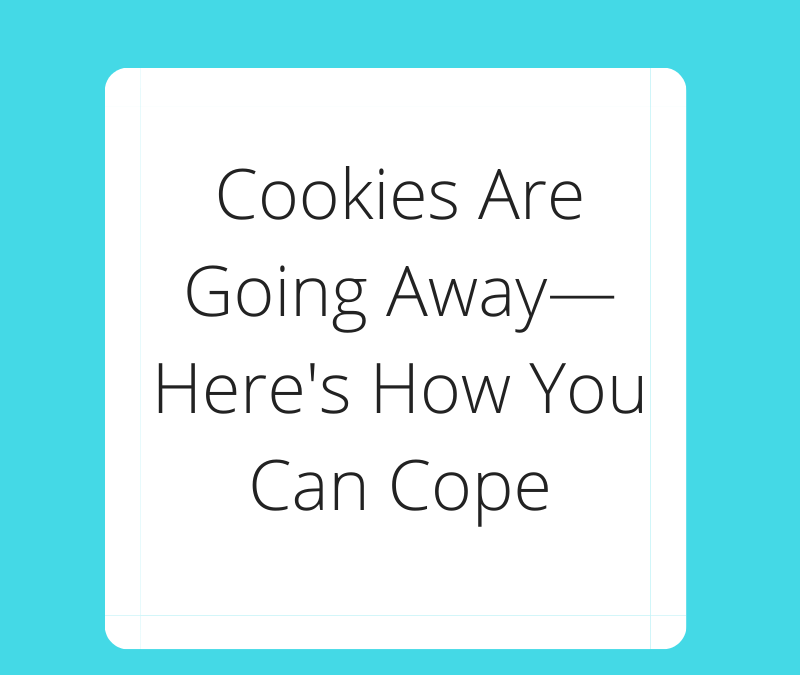Look, I don’t want to alarm you, but big changes are afoot in the world of marketing. And yes, it’s going to affect you.
Marketers and businesses will no longer be able to use third-party cookies to track customer behavior. This isn’t exactly a new idea—in fact, certain web browsers already don’t allow cookies.
In order to help protect its users from being tracked, iOS is no longer communicating user IDs to advertising platforms. Safari and Firefox also have a default setting to block third-party cookies (you can still choose to opt-in if you want), and Chrome plans to phase out third-party cookies by 2023.
I never wanted to envision a world without cookies, but there’s no avoiding it: the cookiepocalypse is coming.
What’s coming
So, what does the death of cookies mean for you? No one’s sure quite yet, but most experts say that data accuracy will take a nosedive. Once Google does away with their third-party tracking, advertisers could potentially lose 30 – 40% of their data. Yikes.
In all likelihood, the absence of cookies will make your job more difficult because:
- The data you gather from your audience reports isn’t going to be as detailed.
- It’s going to be more difficult to get helpful, granular information on your customers’ purchase paths.
- You’ll lose visibility into your attribution models.
This is bad news for us on the consumer side, too. No cookies means less data, which means less relevant ads. So get ready, folks: you’re about to see a slew of spammy ads in your feed again.

What the FLoC?
Of course, data-loving Google isn’t quite ready to give up on the idea of user tracking just yet. It’s been working on an alternative to third-party cookies called “Federated Learning of Cohorts” (FLoC), which will be part of its new “privacy sandbox.”
Instead of tracking each individual with cookies, the browser (Google Chrome) will track their activity locally. People with similar interests will be grouped together in a “cohort” and that data will be reported to other websites that opt in to FLoC.
According to Google, this will hide individuals “in the crowd” so businesses aren’t targeting specific people. Google’s testing shows that businesses should see about 95% of the conversions per dollar compared to cookie-based advertising. And hey, it keeps your browser history private, so it’s a win for consumers, too.
FLoC isn’t without criticism though. Google keeps pushing out its timeline because businesses are wary about supporting the technology.
So what can we do now?
I promise it’s not all doom and gloom, my friend. Collectively, we’re moving toward a more fair and transparent relationship between brands and consumers, and everybody will benefit from that in the long run.
But plenty of businesses—including mine—relied heavily on third-party cookies. Doing away with them leaves a huge, gaping hole in your marketing strategy. If you feel marooned without options, don’t worry. Here are a few tips to make cookie-less marketing as painless as possible.

1. Content is king
It’s a cliché, but it’s true: content is super important. People are consuming more content right now than ever before: if a business wants to survive, it needs to hop on the content bandwagon.
Create a customer persona if you haven’t already. From there, write content for each persona on every platform that your business uses. Consumers want to get to know a brand before making a purchase decision, and your content will help them do just that.
2. Own your customer data
First-party data is where it’s at, guys. Instead of tapping Google or Facebook for consumer data, collect it yourself. An email marketing list is one of the best ways to claim ownership over your customer data.
Offer something of value in exchange for a customer’s information—things like discounts, loyalty programs, or exclusive content. Send surveys to your customers asking why they buy your products, what they love about them, and what problems they solve.
This will build your email list and give you valuable insights into what makes your customers tick. You’ll be able to use this information for future marketing or even future products and services. Nice, right?
3. Continue monitoring your website
Thankfully, you’re still allowed to use first-party cookies on your website (for now). Use that data to track and analyze visitors’:
- Purchase behavior
- Pageviews
- Time on site
… for a better understanding of your target customer. Use this data to optimize your website and give customers a better experience. When in doubt, you can also use a heatmap tool like Hotjar to improve user experience.

4. Diversify
Don’t rely on one single marketing channel. There are pros and cons to every channel, and you won’t know what works best for your business until you give them a try. Content marketing, email marketing, SEO, PPC … the list goes on, so pick one or two to start with. Once you’ve mastered those, keep expanding and trying new things.
5. Stick with social media
Yes, social media is a pay-to-play game for brands. But it’s still an effective way to target your customers. You can still use first-party data to create Lookalike audiences on Facebook or LinkedIn, for example.
If your text ads aren’t converting, shake things up and try a different content medium. According to Animoto, video ads were the number-one way people discovered brands they later purchased from.
The bottom line
Cookies made marketing easier for brands. I’m a little bummed about the change, and like any change in digital marketing, there are sure to be growing pains. Ultimately, cookie-free marketing will be a good change because it will humanize marketing. It’s going to force us to approach our customers not as numbers, but as unique individuals who deserve better relationships with the brands they trust. If you haven’t already, now’s the time to prepare for cookieless marketing. Invest in customer relationships and nurturing campaigns to weather these new changes in digital marketing.

